When I first started exploring woodland photography, I used to believe I needed to capture every detail. Every leaf, every shadow, every bright spot filtering through the canopy.
The logic seemed sound. Woodlands present some of the most challenging lighting conditions in photography. Deep shadows sit alongside brilliant highlights. The dynamic range stretches beyond what any single exposure can handle.
HDR felt like the obvious solution.
But after fifteen years of woodland photography, I’ve come to a different conclusion. Using HDR in woodland photography doesn’t solve the fundamental challenge of photographing forests. Instead, it usually creates new problems whilst missing the point entirely.
Table of Contents
Transform Your Woodland Photos with Simple Editing Techniques
Does your edit ruin your best shots? Learn three simple editing shifts that make your woodland images cleaner, stronger, and more lifelike — even in tricky light.
- Avoid muddy tones and unnatural colours
- Fix contrast and colour without overwhelm
- Create depth and mood in your final images
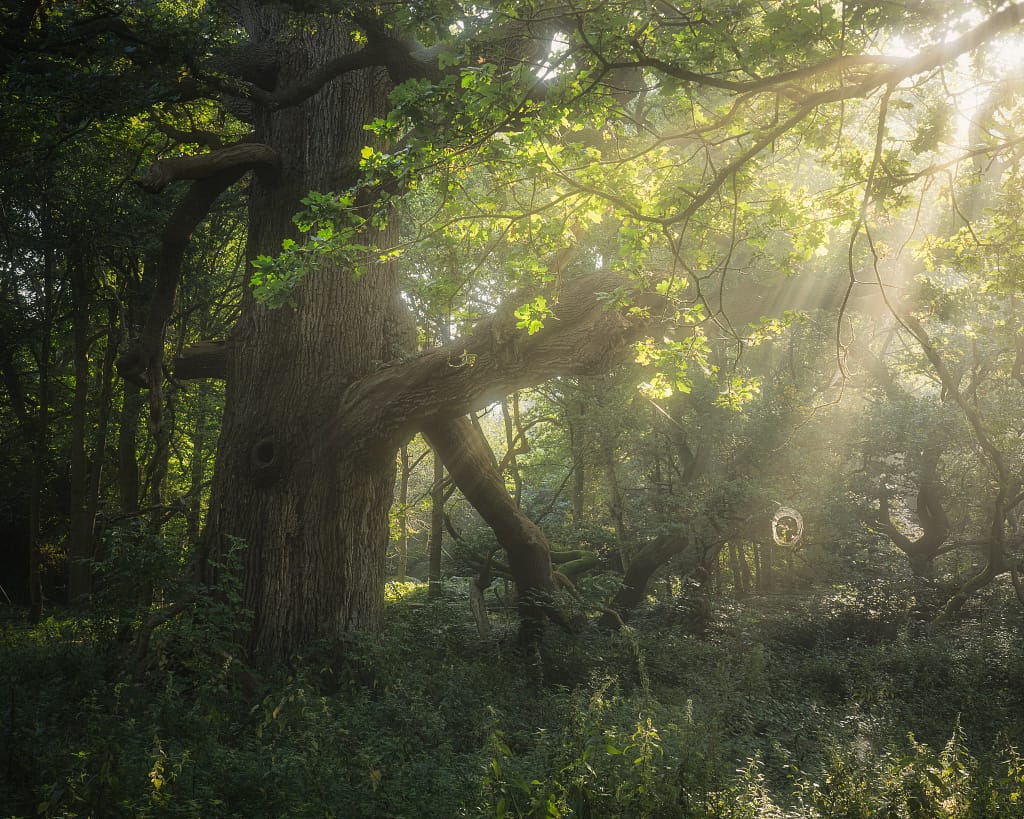
The Visual Clutter Problem
Woods are inherently busy places. Even the simplest composition contains layers of visual information competing for attention. Add harsh sunlight to this complexity and you get chaos. Dappled light creates bright hotspots. Deep shadows carve dark holes through the frame. The eye doesn’t know where to look.
HDR technically solves this by lifting shadows and controlling highlights. But the cure becomes worse than the disease. Everything gets crushed into midtone. The natural rhythm of light and shadow disappears. What should feel organic starts looking artificial. The sun, particularly when it’s higher in the sky, makes woodland photography difficult precisely because it adds visual clutter. HDR removes the clutter but destroys the soul of the image in the process.
The interplay between light and shadow in woodlands creates a complex tapestry of textures and tones. Tree branches cast intricate patterns on the forest floor. Leaves filter sunlight creating ever-shifting displays of illumination. Moss-covered rocks and fallen logs add layers of depth through their varied surfaces. The natural contrast between bright clearings and shadowy understory tells the visual story of the forest.
When photographers attempt to tame this wild contrast through HDR techniques, they often strip away the very essence that makes woodland scenes compelling. The resulting images, while technically well-exposed, lack the dramatic interplay of light that gives forests their mysterious quality. The subtle gradations between highlight and shadow, which guide the viewer’s eye through the scene, become flattened and lifeless.
The challenge of woodland photography lies in embracing rather than fighting these natural contrasts. Working with the available light, understanding its patterns, and choosing compositions that leverage the inherent drama of forest lighting leads to more authentic and engaging images.
Working With Natural Light
I’ve learned to avoid the problem rather than solve it technically. Most of my woodland photographs aren’t shot on sunny days, but that doesn’t mean I avoid them completely. When I do work in bright conditions, it’s during the first or last hour (or so) of daylight when the sun sits low on the horizon. This approach brings harmony to the scene. You have one less thing to worry about, both as the photographer and as the viewer.
During harsh midday light, I change my approach entirely. Instead of fighting the conditions, I look for intimate scenes that exist in natural shade. Sometimes I’ll use an umbrella to create my own patch of softer light. This might sound excessive, but it gives me complete control over the mood and composition. The harsh light stops dictating where I can point my camera. Instead, I can focus on what actually matters: the feeling of being in that space.
The dappled light through the canopy can create distracting hot spots and deep shadows that detract from the scene’s natural beauty. By working in diffused light conditions, whether natural or created, the colors become richer and more saturated. The textures of bark, leaves, and forest floor details emerge with subtle gradations. This lighting approach allows me to capture the woodland’s inherent tranquility and mysterious atmosphere.
Working with natural shade or creating it artificially opens up possibilities throughout the day. The forest’s intricate details, from delicate ferns to moss-covered logs, can be photographed with consistent quality. This technique transforms challenging lighting conditions into opportunities for intimate forest photography.
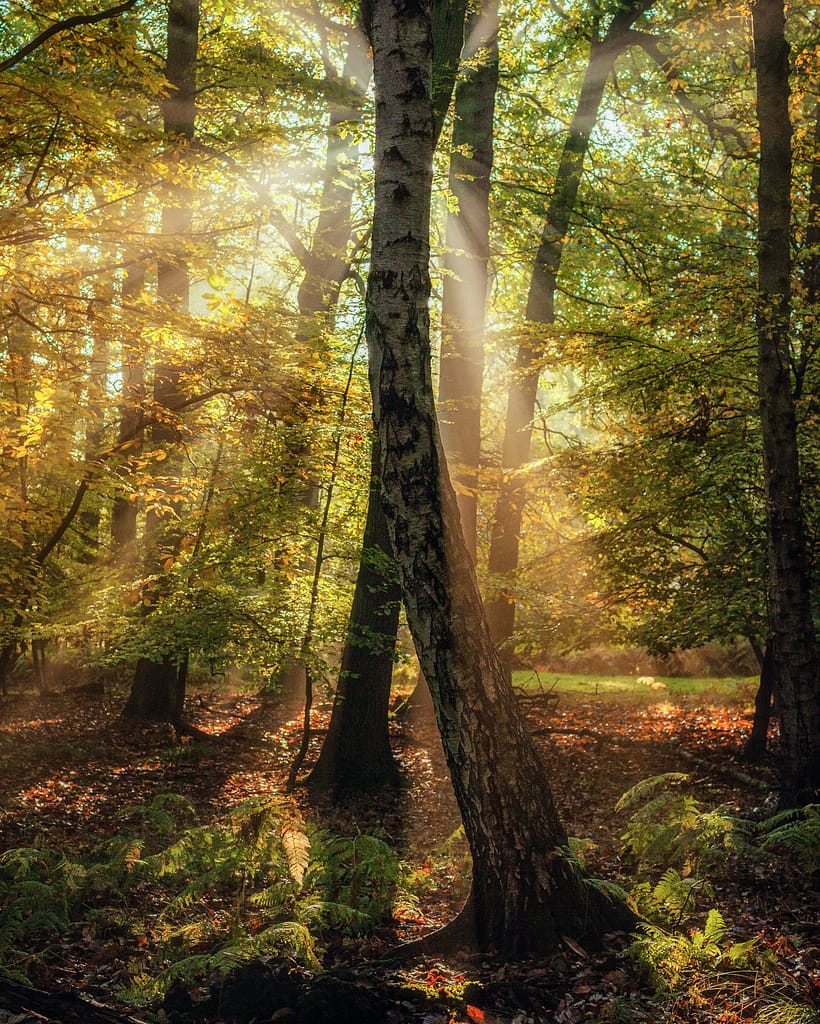
Shadows as Compositional Tools
HDR’s biggest crime is how it treats shadows. By lifting them into visibility, it removes one of photography’s most powerful compositional tools. Shadows guide the viewer’s eye through an image. They create depth, mystery, and visual flow. Remove them and you lose the ability to direct attention.
I try to avoid shadows with no detail, but even the slightest hint of information can create intrigue. Shadows with just enough detail to suggest rather than reveal draw viewers deeper into the frame. This requires a delicate balance. Too much shadow detail and the mystery disappears. Too little and the shadows become dead zones.
Finding this sweet spot comes with time and intuition. The histogram on your camera back helps, especially when set to a flat profile that reveals more detail in your RAW files. The histogram serves as a critical tool for understanding your image’s tonal distribution and ensuring you capture sufficient shadow detail while maintaining the artistic darkness you desire.
For even more control, I process RAW files using a linear profile rather than Adobe’s default colour profile. This involves removing the curve that Adobe automatically applies, giving you independent control over contrast, gamma, brightness, and black and white points. Working with a linear profile allows for precise shadow adjustments, letting you maintain rich blacks while selectively revealing subtle details that add depth and dimension to your images. This approach provides maximum flexibility in post-processing while preserving the natural drama that thoughtfully crafted shadows can bring to a photograph.
While this linear profile technique deserves its own detailed exploration, if you’re looking for practical editing approaches that work beautifully with woodland photography, I’ve put together a guide on simple editing techniques that complement this philosophy of working with natural light rather than against it.
The Technical Reality
Here’s what many photographers don’t realise: you probably don’t need HDR in woodland photography at all. Modern cameras capture 13-14 stops of dynamic range, with some capturing even more. That’s more than sufficient for even complex woodland scenes with extreme contrast.
When I shot film, one of my favourite film stocks, Kodak Portra 160, had around 15 stops of dynamic range. I never struggled with losing highlight or shadow detail, even with the sun in frame, backlighting the entire scene. My exposure could be off by two stops and I’d still retain the detail I needed. The film’s natural response curve meant shadows gracefully faded to black while highlights retained subtle details.
I shot with a Sony Alpha A7R III until recently and rarely felt limited by its dynamic range. Even the decade-old Sony Alpha A7 II handles woodland conditions without breaking a sweat. These cameras excel at capturing both deep shadows under dense canopies and bright highlights breaking through the leaves. The raw files contain abundant recoverable detail in both extremes.
The limitation isn’t your camera. It’s the assumption that you need to capture everything. Not every shadow needs to be lifted, not every highlight needs to be preserved. Natural contrast adds depth and dimension to woodland scenes. Sometimes letting shadows fall to pure black or highlights blow out selectively can enhance the mood and direct viewer attention.
HDR adds complexity without solving the real problem. You’re trading technical simplicity for artificial results. Multiple exposures introduce motion artifacts, processing creates haloing, and the final image often lacks the natural contrast that makes woodland scenes compelling.
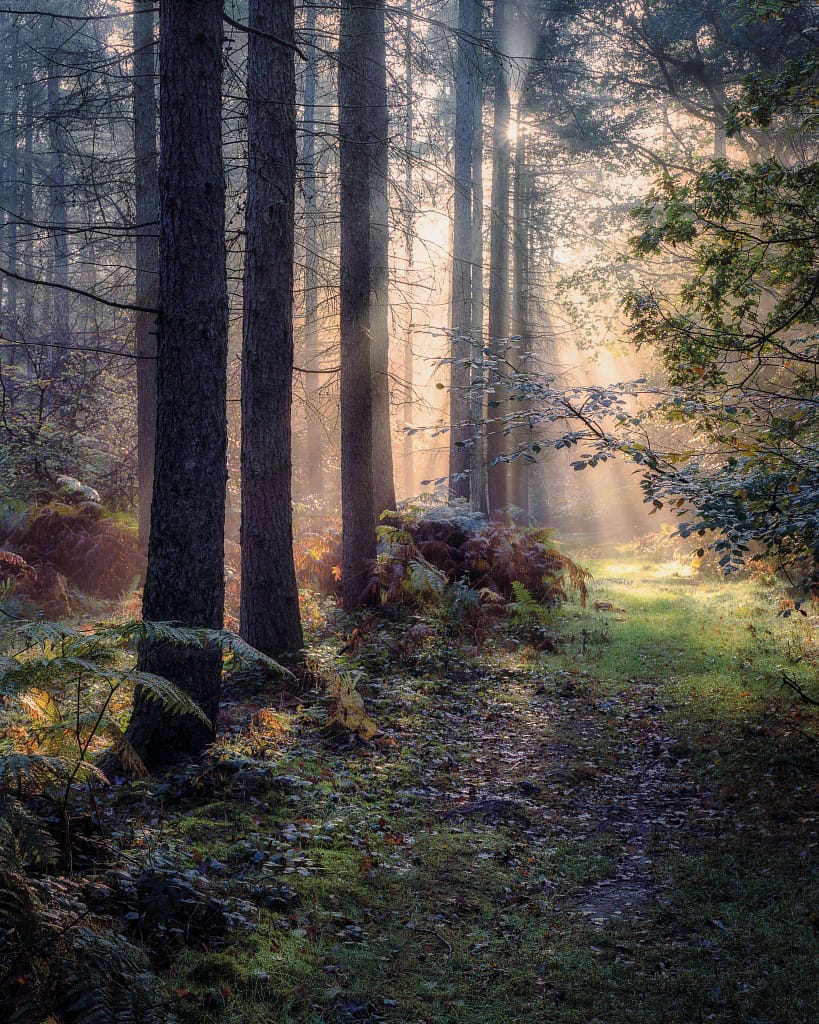
When HDR in Woodland Photography Makes Sense
Despite everything I’ve said, there are rare moments when I do feel the need to capture a higher dynamic range than my camera can capture in a single exposure.
These situations are highly specific: shooting directly into the sun during early morning hours when there’s absolutely no wind, but there are a lot of specular highlights on the leaves (usually caused by dew or overnight rain). In these conditions, HDR provides a small safety net without the usual drawbacks.
When the sun sits low on the horizon, streaming through the trees, the contrast can push even modern sensors to their limits. If I’m capturing a scene where the sun itself is a crucial compositional element, HDR gives me that extra security to retain both the sun’s detail and the foreground shadows.
The key requirement is complete stillness. No breeze moving leaves, no swaying branches. Any movement creates the ghosting artifacts that make HDR in woodland photography problematic.
Even in these ideal conditions, I’m often surprised by how much detail I can recover from a single exposure. Most of the time, careful processing of a single RAW file yields results that match or exceed what HDR would provide.
But on those rare windless mornings when I’m shooting directly into a low sun, HDR becomes a tool rather than a crutch. It’s insurance rather than necessity.
The difference lies in intention. I’m not using HDR to solve a lighting problem or create an artificial look. I’m using it to preserve the authentic feeling of that moment when the forest is backlit by golden morning light.
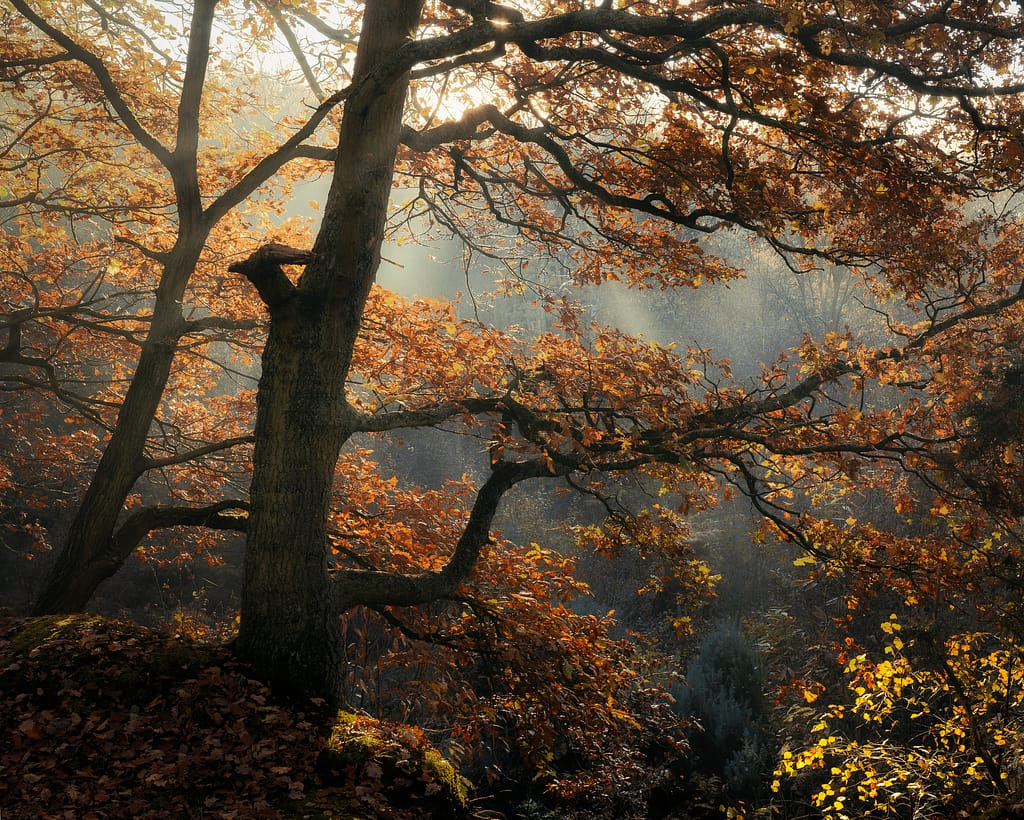
The Authenticity Question
When I process woodland images with careful attention to highlight and shadow balance, something magical happens. The result feels genuine and true to what I experienced. The interplay between light and dark areas creates depth that mirrors the actual forest atmosphere. This isn’t just about matching literal vision – my images blend reality with feeling, preserving the delicate dance of sunbeams through leaves and the mysterious depths of shadowed hollows.
I want to convey something true to the actual scene whilst capturing what it felt like to be there in that moment. The way morning light filters through the canopy, how shadows pool beneath ancient trunks, how highlights accent textured bark and gleaming leaves – these elements work together to recreate both the physical space and emotional resonance of the woodland.
HDR breaks this connection. By flattening the natural contrast, it removes the emotional weight that shadows and highlights carry. The subtle gradations between light and dark that give forest scenes their power become compressed and artificial. The forest stops feeling like a forest. It becomes a technical exercise rather than an emotional experience.
The resulting images may be technically perfect but they lack the vital essence of what makes woodlands so captivating. That interweaving of visible detail and hidden mystery, of revelation and concealment, that mirrors our own experience of moving through these spaces, especially ancient woodland.
From Taking Photos to Taking Walks
The biggest shift in my woodland photography came from changing my entire mindset. Instead of going out to take photos, I started going out for walks. This simple change transformed everything. When you’re not hunting for shots, you become more present. You notice subtleties that would otherwise pass by.
My compass became curiosity. What piques my interest? What makes me pause and look more carefully? Those moments of genuine curiosity signal when a scene deserves to be captured. The forest reveals itself differently when you’re simply walking with open awareness. Small details emerge – the way light filters through leaves, how shadows dance on bark, the subtle textures of moss and lichen.
This approach aligns perfectly with avoiding HDR. Both require patience, presence, and trust in the natural world. You stop trying to force solutions and start working with what’s actually there. The natural light becomes your guide, showing you possibilities rather than limitations. When you’re not fixated on getting specific shots, you discover compositions that feel more authentic and organic.
The woodland environment rewards this patient approach. By slowing down and allowing scenes to unfold naturally, you begin to see photographic opportunities that aren’t immediately obvious. The interplay of light and shadow reveals itself gradually. Patterns and relationships between elements become clear only after quiet observation. This mindset shift transforms woodland photography from a hunt for images into a practice of discovery and presence.
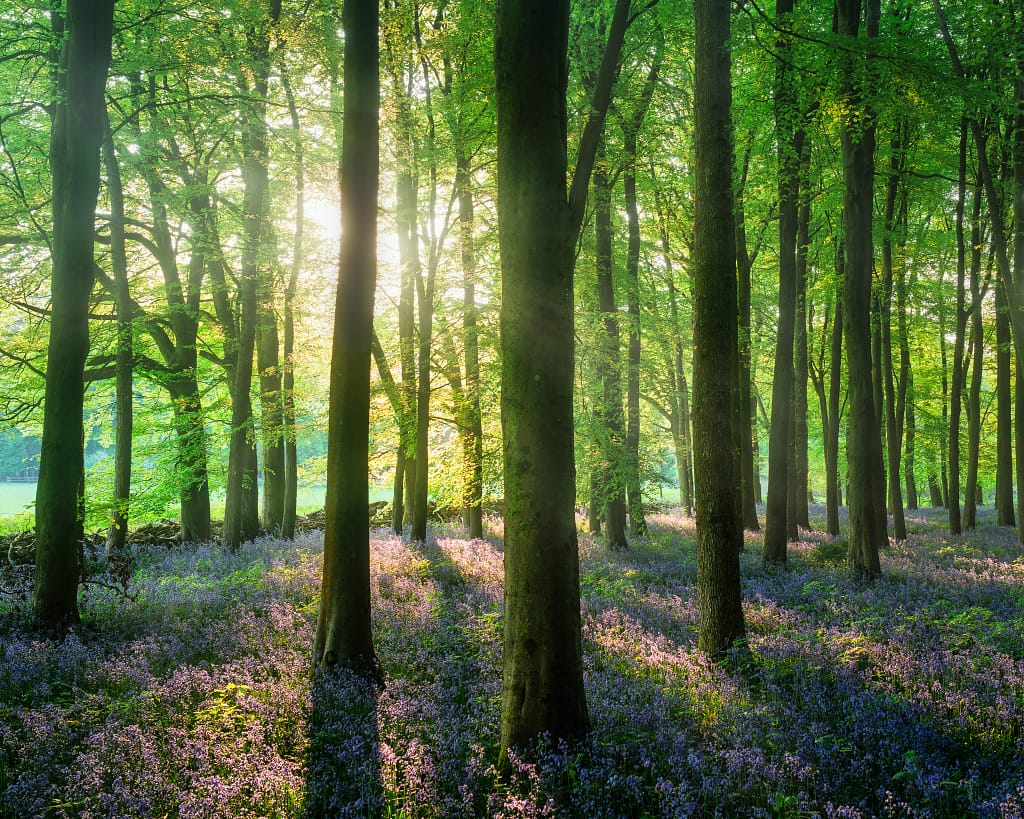
The Timeless Approach
Some of my woodland images from 2009 still appear in my portfolio today. They were shot without HDR, using techniques that prioritised feeling over technical perfection. This longevity isn’t accidental. Images that feel authentic tend to age better than those that rely on technical tricks. HDR dates images to a specific era of digital photography. The telltale signs become obvious over time: the flattened contrast, the artificial colour saturation, the loss of natural light falloff.
Working with natural light and embracing shadows creates images that feel timeless. They don’t scream about the technique used to create them. The organic interplay between light and shadow maintains its appeal across decades, while heavily processed images often become dated artifacts of their time. Natural lighting preserves the depth and dimensionality that makes woodland scenes so captivating. When photographers resist the urge to lift every shadow and boost every highlight, they allow the forest to reveal itself authentically.
The most enduring woodland photographs honor the environment’s natural contrasts and textures. They capture the subtle ways sunlight filters through canopies, the gentle gradients of shade, and the mysterious depths of untouched shadows. This approach creates images that resonate with viewers’ real experiences of forests, rather than presenting an artificially enhanced version that may satisfy technical checkboxes but lacks emotional truth.
What Photographers Are Really Solving
When photographers reach for HDR in woodland photography, they’re usually trying to solve the wrong problem. The real challenge isn’t technical. It’s learning to see differently. It’s developing the patience to work with natural light rather than against it. HDR becomes a crutch that prevents this growth. Instead of learning to read light and shadow, you rely on software to fix everything in post-production.
Natural woodland photography requires understanding how light filters through canopies, creates depth through shadows, and highlights textures on bark and leaves. The interplay between bright spots and dark areas creates the mood and atmosphere that make woodland images compelling. When photographers automatically turn to HDR, they miss the opportunity to develop these crucial observation skills.
I use HDR occasionally in my commercial work, particularly for architecture and real estate photography where showing detail in windows is essential. But that’s a different context with different goals. In woodland photography, the technical challenges usually lead to further technical challenges in post-production. You end up spending more time on your computer than in the forest.
The true art of woodland photography lies in waiting for the right conditions, understanding how different types of light affect the scene, and learning to compose with both highlights and shadows. This patient, observant approach yields more authentic and emotionally resonant images than those artificially balanced through HDR techniques. The forest’s natural contrast and lighting variations should be embraced rather than eliminated.
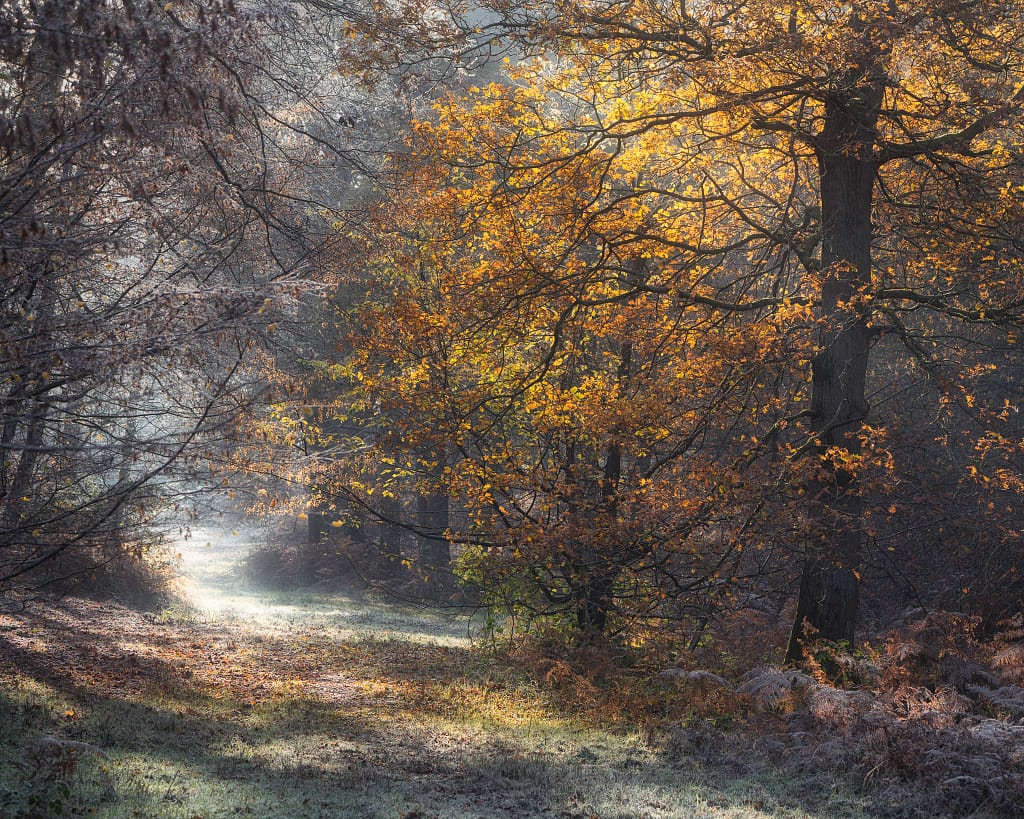
The Path Forward
If you’re currently using HDR for woodland photography, I’d encourage you to try a different approach. Along with changing your technique, it’s worth being aware of the common woodland photography mistakes that can undermine even the best intentions.
Start by choosing your timing more carefully. Avoid harsh midday sun. Work during overcast conditions, in the mist and fog, when it’s raining or during the golden hours when light is naturally softer.
When you do encounter challenging light, look for intimate scenes in natural shade rather than trying to capture everything. Learn to see shadows as friends rather than problems. They add depth, mystery, and visual flow to your compositions.
Most importantly, trust your camera’s dynamic range. Modern sensors capture more information than you probably realise. The goal isn’t to capture every detail. It’s to capture the feeling of being in that space, surrounded by trees, connected to something larger than yourself.
HDR might solve technical problems, but it creates emotional ones. In woodland photography, the emotional connection to your subject – and how you communicate that to the viewer – matters far more than technical perfection.
Let your curiosity guide you. Trust the natural world. Work with the light you’re given rather than trying to create light that doesn’t exist. The forest will reward your patience with images that feel as authentic as the experience of being there.

